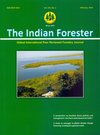A Study on Passages to Global Climate Change Financing:Funding for a Greener Earth
DOI:
https://doi.org/10.36808/if/2016/v142i2/88770Keywords:
Climate Finance, UNFCCC, Multilateral Funds, Bilateral Funds, GHG Emission, NAPCC.Abstract
This paper provides an insight of the present global climate change financing scenario. It develops an understanding of international climate change financing architecture in relation to the various funding mechanism and institutions available at international as well as at nation levels. Contributions by such schemes at global level are discussed at one hand while as India's specific requirements for mitigation and adaptation financing in relation to National Action Plan on Climate Change (NAPCC) is highlighted on the other. Appropriateness of various multilateral and bilateral funding mechanisms for Indian forestry sector with reference to REDD+ is one of the major derivable of the study. Adequacy of such finances to meet various adaptation and mitigation activities, critical nature of funds as being an ODA rather being additionality and the future course of action of UNFCCC are some other vital issues which are fundamentally presented in the paper to make a reader perceptive as well as sensitiveabout the issue.References
Angelsen A., Brown S. and Zarin D. (2009).Reducing emission from deforestation and forest degradation:An options assessment report.
Bird N. and Brown J. (2010).International climate finance:Principles for European support to developing countries. EDC 2020.
Buchner B. Falconer A., Trabacchi C. and Brickman M. (2011). The landscape of climate finance. Venice:Climate policy initiatives.
Brown J., Nanasta D. and Bird N. (2009). Financing climate change to support mitigation and adaptation actions in Africa:Key issues and options for policies and negotiations.
Baer P., Athanasiou T. and Kartha S. (2008). The greenhouse development rights framework:The right to development in a climate constrained world(2nd ed.). Berlin:Hein rich foundation.
Church J.A. and White N.J. (2011). Sea-level rise from the late 19th to early 21st century. Surveys in Geophysics, 32:585-602.
Ghazoul J.R., Buttler A. and Koh L.P. (2010). REDD:A reckoning of development implications. Trends on Ecology and Evolution, 25:396-402.
Global Canopy Foundation. (2009). The little climate finance book. Oxford: GCP, Johnkrebs field station.
Hillman M. (2004). How we can save the planet. London:Penguin.
Haas C., Pfaffing A. and Hendricks S. (2008). Reduced ice thickness in Arctic transpolar drift favors rapid retreat.Geophy.Res.Lett., 35,L17501.
Intergovernmental panel on climate change. (2007). Fifth assessment report,page 131-133.
Informal Working Group Report. (2009). Report on interim finance for REDD+. retrived from www.milyo.no/iwg.
Intergovernmental panel on climate change. (2007). Fifth assessment report, page 136-138.
Kwok R.,Cunningham G.F. and Wensnahan M. (2009). Thinning and volume loss of the Arctic sea ice cover:2003-2008. Journal of Geophysical Research ,114(7):c07005.
Muller B. (2009). Is there room for compromise? The debate on institutional arrangements for climate change. Oxford:Oxford institute for energy studies.
Odedokun M.O. (2003). Economics and politics of official loans versus grants:Panoramic issues and empirical evidence.
Helsinki, Finland. OECD. (2010). Development perceptive for a post2012 climate financing architecture.
Project catalyst. (2009). Scaling up climate finance. Finance brefing paper, September 2009 Stewart R.B., Oppenheimer M. and Rudyk B. (2013). A new strategy for global climate protection. Climate Change, 120(1-2):1-12.
United Nations Framework Convention on Climate Change.(2009). Report of the conference of parties on its fifteenth session, held in Copenhagen. Dec.7-19,2009.
United Nations Framework Convention on Climate Ch.ange. (1992). Article 4, Commitment paragraph.
United Nations Framework Convention on Climate Change. (2007b). Investment and financial flows to address climate change, 2007, Bonn.
World Resources Institute. (2009). Climate analysis indicator tools, Washington, DC.
http//unfccc.int/files/meetings/ad_hoc_working_groups/ilc/application/pdf/finance140809.for para 15 contents.
http://www.thegef.org/gef/whatisgef for para 25th contents.
https://www.adaptation-fund.org/funded_projects/interactive. for para 26th contents.
https://unfccc.int/bodies/green_climate_fund_board/body/6974.php for para 28th contents.
https://www.climateinvestmentfunds.org/cif/node/2 for para 29th contents.
https://www.climateinvestmentfunds.org/cif/node/3 for para 30th contents.
https://www.forestcarbonpartnership.org/. for para 31st contents.
http://www.cbf-fund.org/en for para 35th contents.
Downloads
Downloads
Published
How to Cite
Issue
Section
License
Unless otherwise stated, copyright or similar rights in all materials presented on the site, including graphical images, are owned by Indian Forester.





